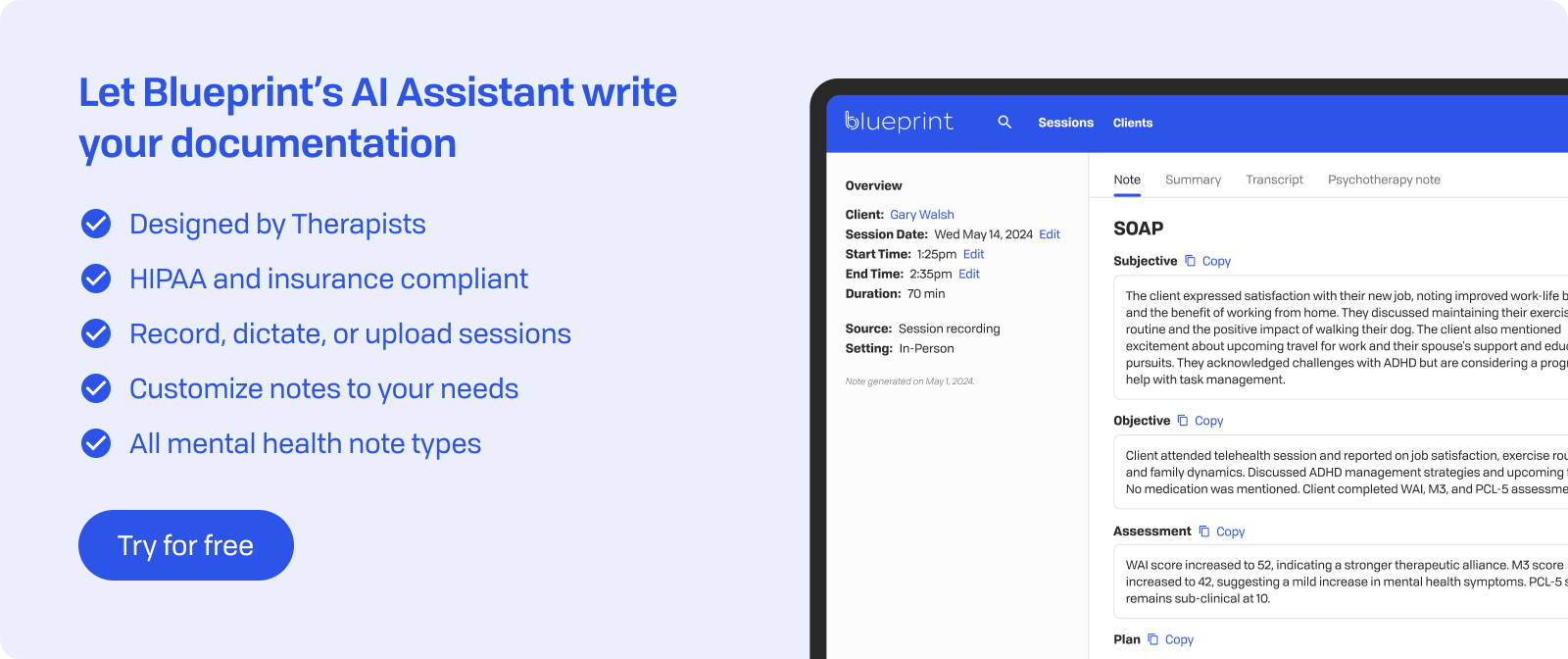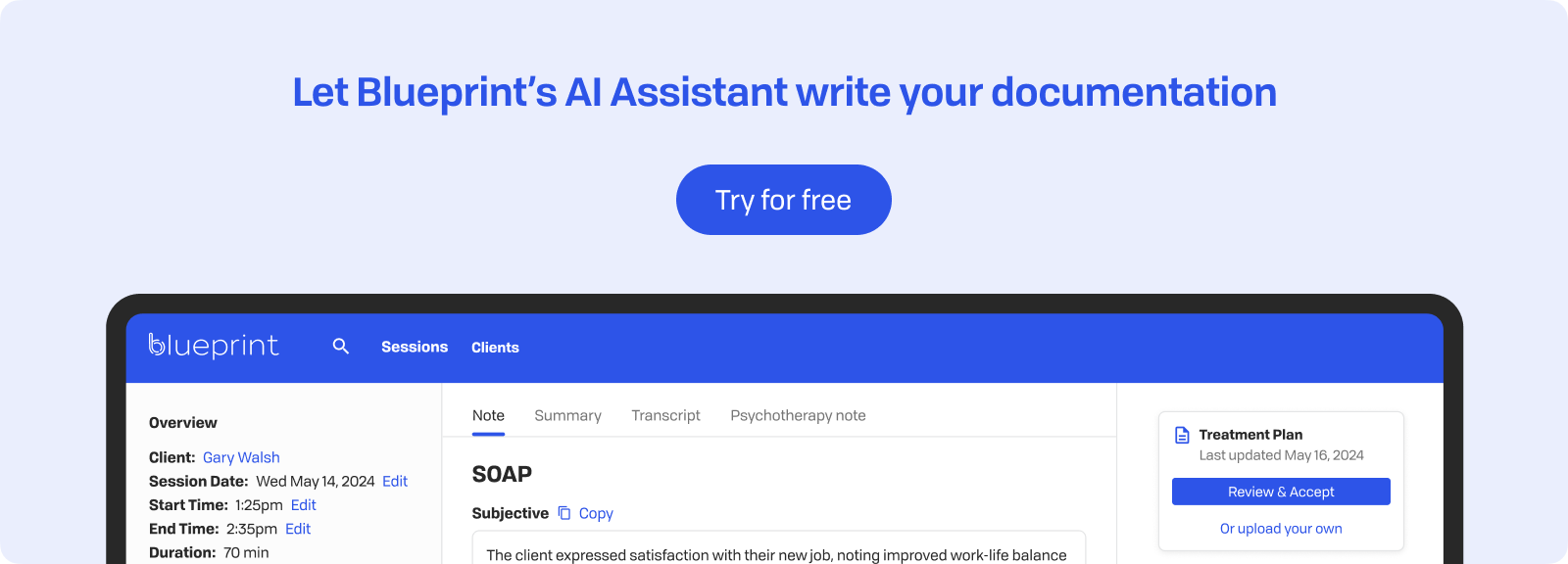In Brief
The decision to go from a solo practitioner to a small group practice, even by hiring just one therapist, is one that is not taken lightly. This decision can shape your practice's future for years, not to mention the type of work you do and the new role of ‘boss’ that you take on. There are many reasons why you might be considering this move to expanding your practice. Whether you’re facing a growing waitlist or noticing early signs of burnout, expanding your team demands careful consideration and planning.
Who, when, and how you hire will affect your bottom line, the care your clients receive, and the professional culture you cultivate. Many practice owners reach the point of making the decision to expand when demand exceeds capacity, when they want to grow professionally in new ways, or when planning for long-term sustainability. Some want to offer more diverse services, while others aim to prevent burnout by sharing the clinical load.
However, poor hiring can create more problems. Mismatched expectations between you and the therapist you hire can lead to rapid turnover, disrupt client care, and drain resources. Besides interpersonal challenges, legal issues can arise, including employment law compliance and credential verification. The stakes are high, so thoughtful, systematic hiring is important for sustainable growth.

Defining Your Needs and Role Clearly
Before posting a job listing, assess the gaps you're trying to fill. Are certain client populations underserved? Do you need expertise in modalities like EMDR or DBT? Perhaps you need a therapist who speaks Spanish or offers evening or weekend appointments.
Your practice model influences the type of therapist to seek. In a solo practice transitioning to a group, prioritize someone comfortable with autonomy who can help establish collaborative systems. In an established group practice, cultural fit and willingness to follow existing protocols might matter more. Decide if you want an employee, independent contractor, or someone who might eventually become a partner.
Also consider the nature of the role: Are you hiring an employee, bringing on an independent contractor, or looking for someone who might eventually move into a leadership or partnership position? Is the therapist role you are hiring for an unlicensed or licensed position? Will you be paying this person a salary, hourly, or using a fee-for-service model?
Additioanlly, a well-crafted job description guides your hiring process. Include specific responsibilities beyond client care, such as documentation requirements, team meeting participation, or marketing contributions. Be transparent about productivity expectations, supervision arrangements, and growth opportunities within your practice. Clear communication from the start helps attract candidates whose goals align with your practice's needs and prevents misunderstandings later.
Where and How to Recruit Qualified Candidates
Finding qualified therapists means spreading your search widely while focusing on quality. The best recruitment strategies blend various channels to reach both active job seekers and passive candidates who could be perfect for your practice.
Consider these primary recruitment channels:
- Professional Networks and Referrals: Use your existing connections through state psychological associations, local therapy groups, and colleague referrals. Personal recommendations often bring in candidates who share similar values and clinical methods.
- Graduate Training Programs: Develop relationships with nearby universities offering counseling, psychology, or social work programs. Offer internship opportunities, guest lectures, or practicum placements to spot promising new therapists early.
- Specialized Job Boards: Post on therapy-specific platforms and behavioral health job sites where mental health professionals actively look for opportunities. General sites like Indeed or LinkedIn are also useful but require more filtering.
- Direct Outreach: Reach out to clinical supervisors at training sites, contact therapists whose work you admire, or connect with professionals presenting at conferences. Personal invitations often draw high-quality candidates.
Your job listings should reflect your practice's distinct culture and values. Include specific details about your therapeutic approach, the client populations you serve, and team dynamics. Highlight what makes your practice unique—whether that's a commitment to evidence-based practices, flexible scheduling, or strong supervision support.
Creative outreach strategies can make you stand out. Host virtual open houses where potential candidates can meet your team, offer continuing education workshops that showcase your expertise, or create informational videos about your practice culture. These methods help candidates picture themselves as part of your team before they even apply.

Evaluating Fit: Screening, Interviewing, and Vetting
Effective screening saves time and ensures you interview only the most promising candidates. Begin with resume reviews, checking for required licensure, relevant experience with your target populations, and alignment with your practice's therapeutic approaches. Follow up with brief 15-20 minute phone calls to assess basic logistical fit—availability, location preferences, insurance panel eligibility, and salary expectations.
Structure your interviews to evaluate both clinical competence and cultural fit. Use standardized questions asked in the same order to each candidate to ensure fair comparison:
- Behavioral questions: "Tell me about a time when you successfully engaged a resistant client" reveals real-world problem-solving skills.
- Situational questions: "How would you handle a client experiencing suicidal ideation during their first session?" tests clinical judgment.
- Philosophy questions: "Describe your approach to treatment planning" uncovers theoretical orientation and collaborative style.
Discuss their views on documentation, boundaries, cultural humility, consultation, and ethical dilemmas. Listen for self-awareness, flexibility, and alignment with your practice values.
Thorough vetting protects your practice and clients. Important verification steps include:
- License verification through state boards, checking for any disciplinary actions.
- Professional references from supervisors or colleagues who can speak to clinical skills.
- Background checks where legally required or appropriate.
- Malpractice history through the National Practitioner Data Bank.
- Educational credentials directly from institutions.
Take detailed notes during each interview using a consistent scoring system. This systematic approach helps you make confident hiring decisions based on objective criteria rather than gut feelings alone.

Onboarding and Setting Up for Success
A well-planned onboarding process helps a new hire become a confident team member who delivers quality care. Begin even before their first day with pre-boarding tasks: complete credentialing paperwork, set up system access, and send a welcoming email that introduces them to the team culture.
Organize their first week to balance information with hands-on experience:
- Day One Basics: Offer office tours, introduce the team, and review basic workflows. Assign a mentor for immediate support and to answer any questions that come up.
- Documentation Training: Guide them through your documentation systems, templates, and compliance requirements. Work with the therapist to create a system for reviewing clinical documentation after completion for an agreed-upon time to make sure it meets your standards.
Regular check-ins help prevent small issues from turning into major problems. Schedule weekly meetings to review administrative questions at first, then move to biweekly as their confidence grows. If the therapist you hired is unlicensed, schedule the required supervision sessions separately from administrative meetings.
If you have a larger practice, foster connection through shared rituals that reinforce your practice culture. This might include weekly peer consultation groups, monthly team lunches, or case presentation rounds where everyone shares insights. Virtual practices can create similar routines through regular video check-ins and online collaboration spaces.
Mentorship can continue beyond initial training. Pair new therapists with experienced colleagues who exemplify your practice's clinical approach and professional standards. Encourage questions, acknowledge the learning curve, and celebrate early successes to build confidence and a sense of belonging.
Integrating into Practice Culture and Systems
To smoothly bring new therapists into your practice, it's important to clearly introduce them to your core values and operational systems. Begin with a structured orientation that covers both the philosophy and the practical aspects.
Introduce new hires to the fundamental elements of your practice:
- Client Care Philosophy: Share your treatment planning approach, session structure, and therapeutic boundaries. Discuss how you combine evidence-based practices with personalized care.
- Documentation Standards: Go over your expectations for progress notes, treatment plans, and compliance needs. Provide templates and examples of well-crafted documentation that meets clinical and legal standards.
- Ethical Guidelines: Explain your position and expectations on ethical practice, including dual relationships, confidentiality protocols, and mandatory reporting procedures. Address common ethical dilemmas specific to your practice setting and create an open door policy so the therapist knows they can contact you at any point in the future if they have a situation they need to discuss.
- Communication Norms: Set expectations for client communication response times, team collaboration protocols, and consultation requirements.
Training on practical systems ensures smooth daily operations:
- Technology Platforms: Offer thorough training on your scheduling system, EHR, billing software, and any telehealth platforms. Provide written guides for quick reference.
- Administrative Processes: Cover intake procedures, insurance verification, billing practices, and client communication protocols.
- Team Structures: Clarify peer consultation groups, supervision arrangements, and administrative meeting schedules.
Involve new therapists in team activities from the beginning. Include them in case consultations to observe clinical reasoning, invite them to participate in administrative huddles to understand practice operations, and encourage questions during team meetings. This active involvement not only speeds up their understanding of practice culture but also helps them build relationships with colleagues.

Evaluating Performance and Growth Over Time
Setting up a structured performance evaluation schedule ensures your new therapist smoothly integrates into your practice while maintaining high standards of care. Plan formal check-ins at 30and 90 days during the initial period, then shift to quarterly reviews for the first year. After that, semi-annual or annual evaluations generally work well for established team members.
Effective performance evaluation draws from various feedback sources:
- Self-Assessments: Ask therapists to reflect on their clinical growth, challenges faced, and goals achieved. This encourages self-awareness and taking ownership of their professional development.
- Client Outcome Data: Look at standardized assessment scores, session attendance rates, and treatment completion statistics to measure therapeutic effectiveness.
- Peer Consultation Input: Collect feedback from colleagues who've observed case presentations or collaborated on shared clients.
- Productivity Metrics: Monitor session volume, documentation timeliness, and completion of administrative tasks while ensuring quality care is not compromised.
- Direct Observation: When suitable, use role-play scenarios or recorded sessions (with consent) to evaluate clinical skills and therapeutic style.
Supporting ongoing professional development shows commitment to your team's growth. Allocate funds for continuing education, including specialized training and workshops relevant to your practice's focus areas. Maintain regular supervision or consultation groups where therapists can discuss theircases and refine their skills. Encourage attendance at professional conferences and consider offering presentation opportunities to build expertise and confidence.
Create personalized development plans based on evaluation findings, identifying specific skills to enhance and resources to support growth. This proactive approach to performance management cultivates a culture of continuous improvement while ensuring your practice maintains high care standards.
Key Takeaways
Clear communication forms the basis of effective therapist hiring—from defining the role initially to evaluating performance regularly. Each step builds on the previous one, creating a thorough approach that safeguards your practice while drawing in outstanding talent.
Use this reliable hiring checklist to simplify your process:
- Define the role: Identify specific needs, necessary skills, and how the position aligns with your practice model.
- Recruit widely and transparently: Utilize multiple channels and clearly communicate your practice values and expectations.
- Screen carefully: Verify credentials, check references, and use structured interviews to assess clinical skills and cultural fit.
- Onboard fully: Offer a thorough orientation that covers both clinical philosophy and practical systems.
- Support integration: Encourage connection through mentorship, regular check-ins, and team involvement.
- Monitor and develop: Set up regular performance reviews and invest in ongoing professional development.
Remember that hiring involves more than just filling a vacancy—it's a chance to enhance your practice's clinical abilities, improve team dynamics, and broaden your therapeutic impact. The time and resources devoted to thoughtful hiring yield benefits like reduced turnover, better client outcomes, and a more sustainable practice model.
The most successful practices view hiring as a continuous process rather than a one-time event. Regular evaluation and adjustment of your hiring practices ensure you keep attracting therapists who align with your mission while adapting to changing market conditions and client needs.

How Blueprint can help streamline your workflow
Blueprint is a HIPAA-compliant AI Assistant built with therapists, for the way therapists work. Trusted by over 50,000 clinicians, Blueprint automates progress notes, drafts smart treatment plans, and surfaces actionable insights before, during, and after every client session. That means saving about 5-10 hours each week — so you have more time to focus on what matters most to you.
Try your first five sessions of Blueprint for free. No credit card required, with a 60-day money-back guarantee.
























